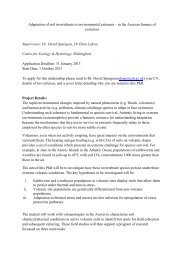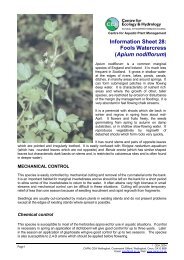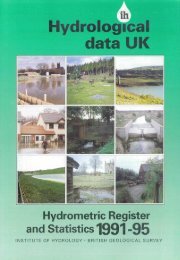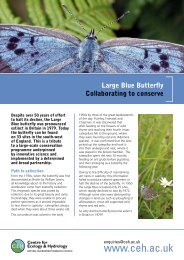ECOFACT Volume 1 Introduction and Approach - Centre for Ecology ...
ECOFACT Volume 1 Introduction and Approach - Centre for Ecology ...
ECOFACT Volume 1 Introduction and Approach - Centre for Ecology ...
Create successful ePaper yourself
Turn your PDF publications into a flip-book with our unique Google optimized e-Paper software.
aggregate classes are well represented, indicating the inherent variability of this l<strong>and</strong>scape. The<br />
upl<strong>and</strong> l<strong>and</strong>scape is dominated by AC VII <strong>and</strong> AC VIII.<br />
• Plot types<br />
Percentage frequency of the six plot types, (ie main, habitat, boundary, hedge, streamside <strong>and</strong><br />
roadside).<br />
Distribution maps, areas <strong>and</strong> lengths<br />
The average area (<strong>for</strong> main plots) <strong>and</strong> length (<strong>for</strong> linear plots) per l<strong>and</strong> class were entered into a<br />
Geographical In<strong>for</strong>mation System (GIS) together with the l<strong>and</strong> class of each 1 km2 in Great<br />
Britain, in order to produce the predictive distribution maps. For main plots, this figure was<br />
weighted according to the relative area of vegetated l<strong>and</strong> in the sample 1 km squares. A statistical<br />
procedure was used to estimate the area of the CVS classes <strong>and</strong> their associated st<strong>and</strong>ard errors.<br />
A similar procedure was followed <strong>for</strong> the relative lengths of the four linear features, except that<br />
the weightings were by length rather than area. Estimates of lengths of the CVS classes along<br />
roadsides, streamsides, hedges <strong>and</strong> boundaries are also provided. Where a class is not<br />
represented by a plot type, the map <strong>for</strong> that plot type is blank or has negligible area or length.<br />
Floristic characteristics<br />
• Species number<br />
A figure is given <strong>for</strong> the total number of species recorded in all the plots found within the<br />
vegetation class.<br />
• Number of species groups<br />
The species recorded from the plots were classified into 37 species groups (Table 1), according to<br />
their ecological dem<strong>and</strong>s (Bunce 1977; Prieto & Sanchez 1992). Each species occurs in only one<br />
group <strong>and</strong> all the species in any given group have similar habitat requirements. The vegetation<br />
classes vary in their species complexity. Management associated with crop production creates a<br />
narrow, uni<strong>for</strong>m range of ecological conditions suitable <strong>for</strong> only a few species of a restricted<br />
ecological range, so that only crop <strong>and</strong> weeds are present, eg species group 1. In contrast, the<br />
woodl<strong>and</strong> plots often contain mixtures of species tolerant of a variety of ecological conditions,<br />
such as grassl<strong>and</strong>, eg species group 27, or dense woodl<strong>and</strong>, <strong>and</strong> plots on the edge of woodl<strong>and</strong>s<br />
may contain species from grassl<strong>and</strong>, scrub <strong>and</strong> tall woodl<strong>and</strong>, eg species group 25. The number of<br />
species groups provides a useful measure of the diversity of the vegetation.<br />
Both the vegetation classes <strong>and</strong> species groups were simultaneously arranged (ordered) according<br />
to the principal gradient described by DECORANA (ie Axis 1 in Figure 1), so that they were ranked<br />
in the same way in the listings, <strong>and</strong> so that users would know that adjacent numbers had more in<br />
common that those further apart.<br />
Table 1. Brief descriptions of the 37 species groups (defined by applying Ward’s minimum<br />
variance clustering of DECORANA scores). Three examples of the list of species belonging to each<br />
group are given in order to provide an overall picture of the composition; the groups are ordered<br />
according to their average DECORANA scores.<br />
Species<br />
group Species group name Characteristic species<br />
1 Crop or crop edge plants on fertile soils Bromus sterilis, Convolvulus arvensis,<br />
Lamium album<br />
2 Crops, crop edge or grassl<strong>and</strong> on eutrophic Elymus repens, Rumex crispus, Sonchus



![Aquatic bryophytes/lower plants [1.54MB, PDF] - Centre for Ecology ...](https://img.yumpu.com/16155793/1/190x143/aquatic-bryophytes-lower-plants-154mb-pdf-centre-for-ecology-.jpg?quality=85)




